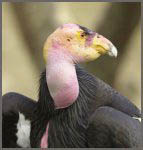The California condor is coming home to San Benito County.
The reintroduction program for the endangered species
– which once commonly graced the rocky cliffs of Pinnacles
National Monument – will begin at the park in early September.
Six condors between 6 months old and 1 year old will be nurtured
and, within three months, released into the wilderness.
The California condor is coming home to San Benito County.
The reintroduction program for the endangered species – which once commonly graced the rocky cliffs of Pinnacles National Monument – will begin at the park in early September.
Six condors between 6 months old and 1 year old will be nurtured and, within three months, released into the wilderness. The program, which has been in progress for three years, is a cooperative effort of Pinnacles National Monument, the U.S. Fish and Wildlife Service, the Ventana Wilderness Society and other wildlife organizations.
“It’s finally almost real,” said park Superintendent Cicely Muldoon. “What’s exciting for us, Pinnacles is a historic nesting ground for the condors. It’s an important link in the whole condor restoration effort.”
A field release pen is scheduled to be completed next week, according to monument officials.
The California condor is on the U.S. Fish and Wildlife Service’s official list of endangered species, which means it is federally protected under the Endangered Species Act.
The scavenger species – the largest bird in North America – has been on the endangered species list since 1967. The California condor populations reportedly began declining in the 1890s, with much of the decrease attributed to hunting and lead poisoning caused by ingestion of ammunition. The worldwide population hit a low point of 27 condors during the late 1970s. Species conservation efforts, similar to the upcoming reintroduction at Pinnacles, have been underway since the early 1980s, and as of Aug. 3, the worldwide population had reached 223, according to Pinnacles Education Specialist Carl Brenner.
“As long as they’re surviving, that’s the whole goal,” Brenner said.
Three regions of the nation accommodate the reintroduction programs, Brenner said. They include the Central Coast, Southern California and Vermil, Ariz., near the Grand Canyon.
The Ventana Wilderness Society has been releasing the condors in Big Sur since 1997.
But the local effort would be the first one conducted in a national park, according to Muldoon.
“It (condor preservation) has really been a remarkable success,” she said.
Four full-time Pinnacles staff members will oversee the program, along with biologists and officials from the Ventana Wilderness Society and the U.S. Fish and Wildlife Service.
Pinnacles officials plan to continue releasing six California condors once a year for the next three years until there is a sustained population of 20.
The condors selected for the September release were bred at the San Diego Zoo and are currently being nurtured by the Ventana Wilderness Society at Big Sur. Also, a grown “mentor” condor will be placed in the pen to help the others mature.
Pinnacles lead biologist Rebecca Leonard said the condors, which will be enclosed in a mesh, see-through pen, must remain in that environment for a minimum of three months.
“They can see everything around them and get a visualization with the land,” Leonard said.
She said the procedure helps the condors become familiar with the surroundings and elicit the birds to eventually return. The California condor, if it chooses, can fly up to 150 to 200 miles a day in search of dead carcasses, Brenner said.
The field release pen is located in the Grassy Canyon area of the park, Brenner said. Visitors will not be allowed access to the structure during the three-month pre-release period. But after that, people may have opportunities to view the endangered condors throughout the park, Brenner said.
“When the birds are released,” Brenner said, “they’ll go wherever they want.”
California condors resemble turkey vultures, according to Brenner. They are large, black and have white triangles under each wing, the spans of which can reach 9-1/2 feet. Adults have multi-colored heads while juveniles’ heads are black or gray.
A reported California condor presence at Pinnacles National Monument dates back to the late 1800s, and a significant population nested throughout the Gabilan Mountains during the 1970s, according to the Ventana Wilderness Society.
“I think it’s going to be really exciting for the folks in San Benito County to see what their grandparents saw,” Muldoon said. “I think it says a lot for the land stewardship that has gone on here for generations.”










